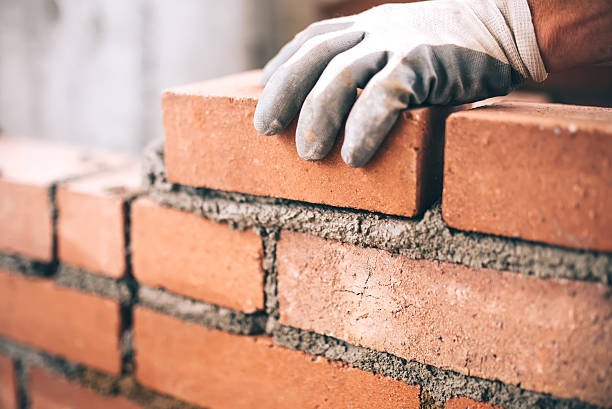Unlocking the Tricks of Sustainable Masonry Building Practices for Eco-Friendly Buildings
In the realm of modern-day building, the search of lasting practices has become critical. Amongst the myriad methods to environment-friendly structure, lasting masonry building and construction stands apart as a tried and true and resilient method that holds a wealth of untapped possibility. From the selection of materials to ingenious construction techniques, the keys to achieving sustainability within masonry construction are diverse and fascinating. By discovering the advantages, products, techniques, and future trends of lasting masonry, a deeper understanding of exactly how these techniques can form the future of environment-friendly structures emerges.
Benefits of Lasting Masonry Construction
Embracing sustainable masonry construction methods not just lowers ecological influence yet additionally supplies long-lasting financial advantages to builders and neighborhoods. By utilizing materials like recycled blocks, blocks, and stones, home builders can considerably reduce the carbon impact of their jobs while promoting resource effectiveness. In addition, sustainable masonry building strategies, such as appropriate insulation and thermal mass properties, can improve energy efficiency within buildings, resulting in minimized operational expenses in time.
Furthermore, the sturdiness and strength of masonry frameworks add to lasting financial advantages. Structures created using sustainable masonry methods usually need much less repair and maintenance, equating to cost savings for home builders and homeowner. The durability of masonry products likewise makes sure that frameworks stay stable and secure, minimizing the demand for constant restorations or substitutes.
Eco-Friendly Stonework Materials
Making use of environment-friendly masonry materials is a pivotal action in the direction of improving the sustainability of construction practices and decreasing environmental impact while optimizing long-lasting financial advantages. Lasting stonework products are sourced, generated, and used in a fashion that lowers total ecological influence. Sustainable concrete obstructs integrate recycled aggregates and might feature enhanced insulation residential properties, adding to power efficiency in structures.
In addition, all-natural materials like adobe, rammed planet, and straw bales provide superb thermal mass residential or commercial properties, reducing the demand for home heating and cooling down energy. These materials are typically locally readily available, promoting local economic climates and minimizing transportation-related carbon discharges. By picking eco-friendly masonry products, construction projects can considerably minimize their environmental impact and add to the creation of much healthier, much more sustainable built environments.
Energy-Efficient Masonry Methods
Power efficiency plays an essential duty in improving the sustainability of stonework building methods. By carrying out energy-efficient stonework methods, contractors can significantly decrease the nissan dealership general power consumption of a building, resulting in reduced operational expenses and a smaller sized ecological impact. One key energy-efficient masonry strategy is making use of thermal mass, which entails integrating dense products like concrete or brick right into the building's structure to absorb and keep warm. This helps manage indoor temperature levels, decreasing the need for mechanical heating and cooling down systems.

Innovations in Lasting Masonry
Current improvements in lasting stonework practices have actually caused innovative methods that are reshaping the building and construction sector. One such advancement is the development of self-healing concrete, which utilizes bacteria installed within the concrete to heal fractures autonomously. This development not just decreases upkeep expenses but additionally enhances the durability of stonework structures, adding to their sustainability.
One more notable innovation is the usage of recycled accumulations in stonework building - masonry contractor. By integrating products such as crushed ceramic waste or recycled glass right into concrete mixes, building contractors can decrease the environmental impact of building and construction projects while preserving architectural stability. This technique not only diverts waste from land fills however additionally preserves natural deposits, making it an essential advancement in sustainable masonry building
Additionally, the integration of electronic layout tools, such as Building Information Modeling (BIM), is reinventing the method masonry structures are prepared and created. BIM permits more precise computations, minimized product waste, and boosted energy effectiveness, eventually causing even more lasting building practices. These technologies jointly signify an appealing future for sustainable stonework construction in the age of environmentally friendly structures.
Future Trends in Stonework Sustainability
With the innovative strides made in lasting masonry techniques, the future patterns in masonry sustainability are check this site out positioned to further transform the building and construction market. One of the essential trends shaping the future of masonry sustainability is the boosted combination of technology. Developments such as Building Details Modeling (BIM) and online truth simulations are being made use of to optimize stonework building procedures, leading to reduced product waste and improved power effectiveness in buildings.
Additionally, the growth of novel lasting materials is set to play a considerable role in improving the eco-friendliness of masonry construction. masonry contractor. Technologies like self-healing concrete, recycled aggregates, and bio-based binders are gaining grip for their ability to decrease environmental influence while keeping structural stability

Conclusion
In verdict, sustainable masonry building and construction methods provide various advantages for green buildings. By using environmentally friendly products and energy-efficient methods, stonework can contribute to an extra lasting built setting. Technologies in sustainable masonry are constantly being developed to better enhance the environmental performance of buildings. Looking towards the future, the fad of masonry sustainability is anticipated to grow, causing even more eco-friendly and energy-efficient building and construction techniques in the years to come.